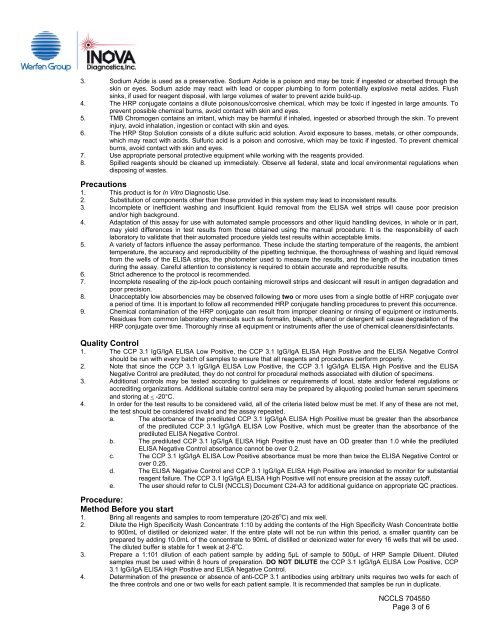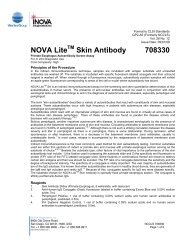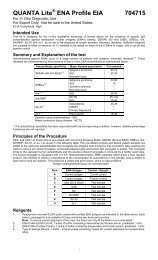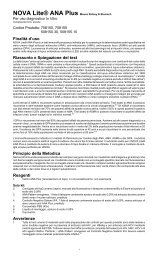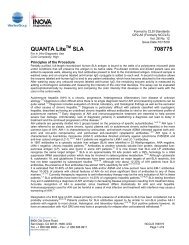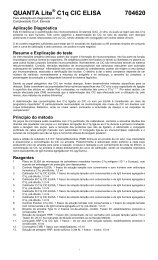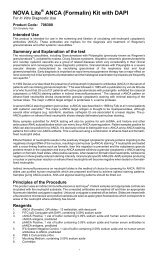QUANTA Lite CCP3.1 IgG/IgA ELISA 704550 - inova
QUANTA Lite CCP3.1 IgG/IgA ELISA 704550 - inova
QUANTA Lite CCP3.1 IgG/IgA ELISA 704550 - inova
- No tags were found...
You also want an ePaper? Increase the reach of your titles
YUMPU automatically turns print PDFs into web optimized ePapers that Google loves.
3. Sodium Azide is used as a preservative. Sodium Azide is a poison and may be toxic if ingested or absorbed through theskin or eyes. Sodium azide may react with lead or copper plumbing to form potentially explosive metal azides. Flushsinks, if used for reagent disposal, with large volumes of water to prevent azide build-up.4. The HRP conjugate contains a dilute poisonous/corrosive chemical, which may be toxic if ingested in large amounts. Toprevent possible chemical burns, avoid contact with skin and eyes.5. TMB Chromogen contains an irritant, which may be harmful if inhaled, ingested or absorbed through the skin. To preventinjury, avoid inhalation, ingestion or contact with skin and eyes.6. The HRP Stop Solution consists of a dilute sulfuric acid solution. Avoid exposure to bases, metals, or other compounds,which may react with acids. Sulfuric acid is a poison and corrosive, which may be toxic if ingested. To prevent chemicalburns, avoid contact with skin and eyes.7. Use appropriate personal protective equipment while working with the reagents provided.8. Spilled reagents should be cleaned up immediately. Observe all federal, state and local environmental regulations whendisposing of wastes.Precautions1. This product is for In Vitro Diagnostic Use.2. Substitution of components other than those provided in this system may lead to inconsistent results.3. Incomplete or inefficient washing and insufficient liquid removal from the <strong>ELISA</strong> well strips will cause poor precisionand/or high background.4. Adaptation of this assay for use with automated sample processors and other liquid handling devices, in whole or in part,may yield differences in test results from those obtained using the manual procedure. It is the responsibility of eachlaboratory to validate that their automated procedure yields test results within acceptable limits.5. A variety of factors influence the assay performance. These include the starting temperature of the reagents, the ambienttemperature, the accuracy and reproducibility of the pipetting technique, the thoroughness of washing and liquid removalfrom the wells of the <strong>ELISA</strong> strips, the photometer used to measure the results, and the length of the incubation timesduring the assay. Careful attention to consistency is required to obtain accurate and reproducible results.6. Strict adherence to the protocol is recommended.7. Incomplete resealing of the zip-lock pouch containing microwell strips and desiccant will result in antigen degradation andpoor precision.8. Unacceptably low absorbencies may be observed following two or more uses from a single bottle of HRP conjugate overa period of time. It is important to follow all recommended HRP conjugate handling procedures to prevent this occurrence.9. Chemical contamination of the HRP conjugate can result from improper cleaning or rinsing of equipment or instruments.Residues from common laboratory chemicals such as formalin, bleach, ethanol or detergent will cause degradation of theHRP conjugate over time. Thoroughly rinse all equipment or instruments after the use of chemical cleaners/disinfectants.Quality Control1. The CCP 3.1 <strong>IgG</strong>/<strong>IgA</strong> <strong>ELISA</strong> Low Positive, the CCP 3.1 <strong>IgG</strong>/<strong>IgA</strong> <strong>ELISA</strong> High Positive and the <strong>ELISA</strong> Negative Controlshould be run with every batch of samples to ensure that all reagents and procedures perform properly.2. Note that since the CCP 3.1 <strong>IgG</strong>/<strong>IgA</strong> <strong>ELISA</strong> Low Positive, the CCP 3.1 <strong>IgG</strong>/<strong>IgA</strong> <strong>ELISA</strong> High Positive and the <strong>ELISA</strong>Negative Control are prediluted, they do not control for procedural methods associated with dilution of specimens.3. Additional controls may be tested according to guidelines or requirements of local, state and/or federal regulations oraccrediting organizations. Additional suitable control sera may be prepared by aliquoting pooled human serum specimensand storing at < -20°C.4. In order for the test results to be considered valid, all of the criteria listed below must be met. If any of these are not met,the test should be considered invalid and the assay repeated.a. The absorbance of the prediluted CCP 3.1 <strong>IgG</strong>/<strong>IgA</strong> <strong>ELISA</strong> High Positive must be greater than the absorbanceof the prediluted CCP 3.1 <strong>IgG</strong>/<strong>IgA</strong> <strong>ELISA</strong> Low Positive, which must be greater than the absorbance of theprediluted <strong>ELISA</strong> Negative Control.b. The prediluted CCP 3.1 <strong>IgG</strong>/<strong>IgA</strong> <strong>ELISA</strong> High Positive must have an OD greater than 1.0 while the prediluted<strong>ELISA</strong> Negative Control absorbance cannot be over 0.2.c. The CCP 3.1 <strong>IgG</strong>/<strong>IgA</strong> <strong>ELISA</strong> Low Positive absorbance must be more than twice the <strong>ELISA</strong> Negative Control orover 0.25.d. The <strong>ELISA</strong> Negative Control and CCP 3.1 <strong>IgG</strong>/<strong>IgA</strong> <strong>ELISA</strong> High Positive are intended to monitor for substantialreagent failure. The CCP 3.1 <strong>IgG</strong>/<strong>IgA</strong> <strong>ELISA</strong> High Positive will not ensure precision at the assay cutoff.e. The user should refer to CLSI (NCCLS) Document C24-A3 for additional guidance on appropriate QC practices.Procedure:Method Before you start1. Bring all reagents and samples to room temperature (20-26 o C) and mix well.2. Dilute the High Specificity Wash Concentrate 1:10 by adding the contents of the High Specificity Wash Concentrate bottleto 900mL of distilled or deionized water. If the entire plate will not be run within this period, a smaller quantity can beprepared by adding 10.0mL of the concentrate to 90mL of distilled or deionized water for every 16 wells that will be used.The diluted buffer is stable for 1 week at 2-8 o C.3. Prepare a 1:101 dilution of each patient sample by adding 5µL of sample to 500µL of HRP Sample Diluent. Dilutedsamples must be used within 8 hours of preparation. DO NOT DILUTE the CCP 3.1 <strong>IgG</strong>/<strong>IgA</strong> <strong>ELISA</strong> Low Positive, <strong>CCP3.1</strong> <strong>IgG</strong>/<strong>IgA</strong> <strong>ELISA</strong> High Positive and <strong>ELISA</strong> Negative Control.4. Determination of the presence or absence of anti-CCP 3.1 antibodies using arbitrary units requires two wells for each ofthe three controls and one or two wells for each patient sample. It is recommended that samples be run in duplicate.NCCLS <strong>704550</strong>Page 3 of 6


